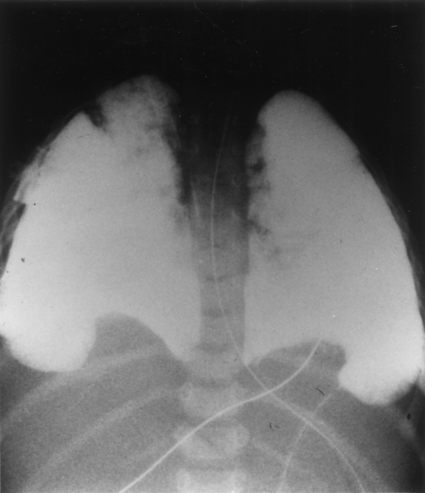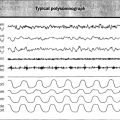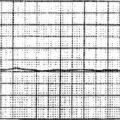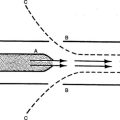Liquid Ventilation
I History of Liquid Ventilation
A The first successful use of total liquid ventilation was in dogs in 1966.
B During this period liquid ventilation was researched in the hope that individuals would be able to remain under water for long periods with respiration supported by a fluid media.
C The first fluid used for liquid ventilation was saline.
D Fuhrman first described partial liquid ventilation in 1991.
E The first reported series of patients (neonates) maintained with partial liquid ventilation was in 1996.
F The last randomized controlled trial of partial liquid ventilation in adults was completed in 2001.
II Definitions and Descriptions
1. The movement of a liquid into and out of the lungs with each breath.
2. This is accomplished with a system similar to an extracorporeal membrane oxygenation system.
3. A gas exchanger, heater, and pump are necessary.
4. Total liquid ventilation systems have only been used on animal models; no patient has ever been maintained with a total liquid ventilation system.
1. The lung is filled with a liquid to approximately 50% to 100% of functional residual capacity (FRC).
2. On top of the liquid the patient is conventionally mechanically ventilated.
3. Partial liquid ventilation is the only approach ever used in patients.
1. Carbon-based chemicals are used as the liquid media for all approaches to liquid ventilation.
2. A number of different perfluorocarbons have been used in animal models, but only one, Perflubron (C8F17 Br; Alliance Pharmaceuticals, San Diego, CA) has been used in patients.
3. Box 46-1 lists the physical properties of Perflubron.
4. Other perfluorocarbons used for liquid ventilation include
III Mechanisms of Action of Perflubron
1. Because Perflubron has a high density it prevents fluid and protein from moving across the alveolar capillary membrane into the lung.
1. Perflubron improves survival of pneumonia in animal models.
2. In cell cultures it decreases the number of viable bacteria.
1. The high density and the insolubility of Perflubron move cellular debris from the lung periphery to the top of the Perflubron column for removal by suctioning.
2. It is occasionally necessary to instill saline into the airway to remove thick secretions on the top of a Perflubron column.
D Redistribution of pulmonary blood flow
1. Because Perflubron primarily distributes to gravity-dependent lung, its high density moves blood flow to the nondependent lung.
2. Because most gas ventilation during partial liquid ventilation is in nondependent lung, V/Q matching is improved.
IV Filling of the Lung with a Perfluorocarbon
A The only method to fill the lung with a perfluorocarbon is to slowly instill it into the lung (Figure 46-1).
B This instillation can be controlled by intravenous pump, but careful monitoring during instillation is critical.
C Adverse events have been frequently reported during dosing.
D Because perfluorocarbons have a high vapor pressure, they rapidly evaporate, requiring regular refilling.
E The evaporation rate for adults is approximately 1 ml/kg/hr but depends on minute ventilation.
V Conventional Ventilation During Partial Liquid Ventilation
A A high level of PEEP (≥13 cm H2O) is required during partial liquid ventilation to move the Perflubron out of central airways.
B If inadequate PEEP is applied, high peak airway pressure is necessary.
C Tidal volume (Vt) should be low during partial liquid ventilation.
D During most human trials in the 1990s, large Vts were used that resulted in a high pneumothorax rate.
E Vts should be maintained at approximately 6 ml/kg ideal body weight.
F Respiratory rate is limited by air trapping.
G The rate should not prevent normal exhalation.
H Spontaneous ventilation should be avoided during partial liquid ventilation because of increased work of breathing.
VI Monitoring During Partial Liquid Ventilation
A Figure 46-2 illustrates a lung filled with Perflubron to FRC.
B Because of the bromide atom on the end of the Perflubron chain, the Perflubron is easily identified on radiographs.
C Pneumothorax, consolidation, and the complete outline of the lung are easy to observe in the Perflubron-filled lung.
D Careful monitoring for the development of pneumothorax is critical. The incidence of pneumothorax during partial liquid ventilation is high.
E Plateau pressure should be kept <30 cm H2O as in all forms of mechanical ventilation.
F Hemodynamic stability should be carefully monitored because of the high local mean airway pressure established.
A Partial liquid ventilation has not demonstrated an improvement in outcome in patients with acute respiratory distress syndrome (ARDS).
B As a result it is unlikely that it will become part of the normal clinical care of patients with ARDS in the near future.
C Experimentation using high frequency oscillation is ongoing in animal models.
D Many believe perfluorocarbons may be useful in single small doses to help recruit the lung.
E Animal trials using vaporized or aerosolized perfluorocarbons are currently ongoing.
F The entire concept of liquid ventilation must still be considered experimental.









